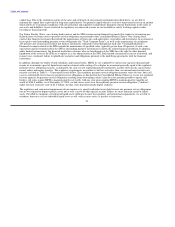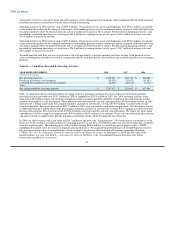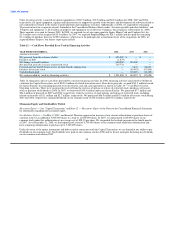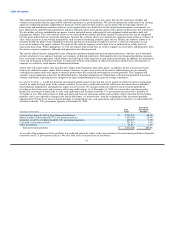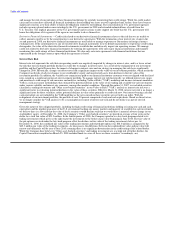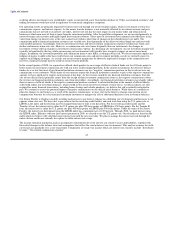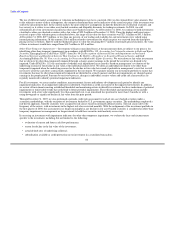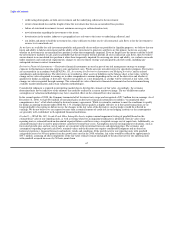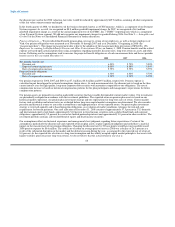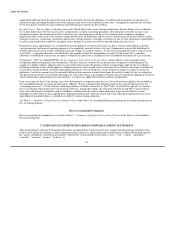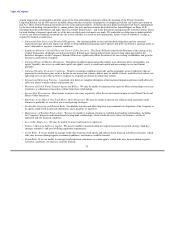MoneyGram 2008 Annual Report Download - page 65
Download and view the complete annual report
Please find page 65 of the 2008 MoneyGram annual report below. You can navigate through the pages in the report by either clicking on the pages listed below, or by using the keyword search tool below to find specific information within the annual report.
Table of Contents
and manage the risk of concentration at these financial institutions by regularly monitoring their credit ratings. While the credit market
crisis and recession have affected all financial institutions, those holding our assets are well capitalized and, to date, there have been no
significant concerns as to their ability to honor all obligations related to our holdings. The concentration in U.S. government agencies
includes agencies placed under conservatorship by the U.S. government in 2008 and extended unlimited lines of credit from the
U.S. Treasury. The implicit guarantee of the U.S. government and its actions to date support our belief that the U.S. government will
honor the obligations of its agencies if the agencies are unable to do so themselves.
Derivative Financial Instruments — Credit risk related to our derivative financial instruments relates to the risk that we are unable to
collect amounts owed to us by the counterparties to our derivative agreements. With the termination of our interest rate swaps in the
second quarter of 2008, our derivative financial instruments are used solely to manage exposures to fluctuations in foreign currency
exchange rates. If the counterparties to any of our derivative financial instruments were to default in payments or experience credit rating
downgrades, the value of the derivative financial instruments would decline and adversely impact our operating income. We manage
credit risk related to derivative financial instruments by entering into agreements with only major financial institutions and regularly
monitoring the credit ratings of these financial institutions. We also only enter into agreements with financial institutions that are
experienced in the foreign currency upon which the agreement is based.
Interest Rate Risk
Interest rate risk represents the risk that our operating results are negatively impacted by changes in interest rates, and to a lesser extent,
the risk that our investment portfolio declines in value due to changes in interest rates. As a result of the realignment of our investment
portfolio and the Capital Transaction, the impact of changes in interest rates and our strategy in managing this risk have significantly
changed in 2008. Historically, changes in interest rates had a significant impact on the value of our investment portfolio, which meant the
Company faced risks of adverse changes to our stockholders' equity and unrestricted assets from declines in the fair value of the
investment portfolio. In addition, the variable rate commissions paid to our financial institution customers were not aligned with the fixed
rates earned on a significant portion of our investment portfolio. To manage interest rate risk historically, we utilized interest rate swaps
and monitored a wide range of risk measures and analyses, including Value-at-Risk ("VAR") modeling and income statement simulation.
VAR is a risk assessment methodology that estimated the potential decline in the value of our trading and available-for-sale investments
under various volatility and interest rate scenarios, among other market conditions. Through December 31, 2007, we included securities
classified as trading investments and "Other asset-backed securities" in our Value-at-Risk ("VAR") analysis as interest rate risk was a
significant factor in evaluating potential declines in the value of these securities. Effective March 31, 2008, interest rate risk is no longer a
significant factor for these securities; rather, potential declines in value relate primarily to credit risk now. Our interest-bearing cash and
cash equivalents are not included in the VAR modeling as the rates earned on these securities are not tied to an index. With the
realignment of our investment portfolio, the portfolio is now 90 percent comprised of cash and cash equivalents. Based on these factors,
we no longer consider the VAR analysis to be a meaningful assessment of interest rate risk and do not utilize it as part of our risk
management strategy.
Given the nature of the realigned portfolio, including the high credit rating of financial institutions holding or issuing our cash and cash
equivalents and the implicit guarantee of the U.S. government backing our money markets and majority of available-for-sale investments,
we believe there is a low risk that the value of these securities would decline such that we would have a material adverse change in our
stockholders' equity. At December 31, 2008, the Company's "Other asset-backed securities" are priced on average at four cents on the
dollar for a total fair value of $29.5 million. In the fourth quarter of 2008, the Company opted in to a buy-back program related to its
trading investments which gives us the right to put the investments to the broker at par value beginning in June 2010. The fair value of
the put options received under the buy-back program offset the declines in fair value of the trading investments below par. At
December 31, 2008, the combined fair value of the trading investments and related put options was $48.0 million as compared to the
$62.3 million par value of the trading investments. As time passes, the difference between the combined fair value and par value will
narrow and ultimately will be zero at June 2010 assuming there is no significant deterioration in the credit rating of the related broker.
While the Company does believe its "Other asset-backed securities" and trading investments are at a high risk of further decline, the
Capital Transaction completed on March 25, 2008 included funds to cover all losses on these securities. Accordingly, any
62



